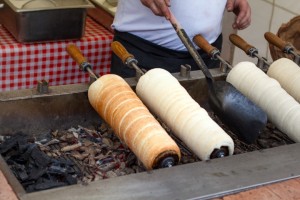A traditional Hungarian festive season simply couldn’t take place without three tasty treats. The holy trinity of Kürtőskalács (Chimney cake), Bejgli (rolled yeast dough filled traditionally with walnut or poppy seeds) and Szaloncukor (fondant, covered with chocolate) is still unbeatable. You should be able to find these delicacies on almost every Hungarian Christmas table but what’s the history behind them?
Hungarian Festive Food #1: The Shiny Candies

A Hungarian Christmas just isn’t complete without small chocolates covered in shiny paper and hanging on the Christmas tree.
Some date this tradition back to 14th century France and was then called fondantcukor. French pastry chef Pierre-Andre Manion introduced the recipe to Germany in the 17th century. These fondant treats reached Hungary in the 19th Century when German craftsmen moved here.
The mass production of fondant candies wrapped in foil packaging began using steam powered engines in 1883 in Hungary, with most of the production dedicated to creating traditional cakes for the Gerbeaud brand. A cookbook dating back to 1891 lists no less than 17 different recipes for making szaloncukor.
Hungarian Festive Food #2: Poppy Seed and Walnut Heaven

The poppy seed roll is a pastry consisting of a roll of sweet yeast bread (a viennoiserie to be precise) with a dense, rich filling of poppy seeds or ground walnuts.
This hardly heavy but nonetheless delicious cake is popular in parts of Central and Eastern Europe and commonly eaten at Christmas time. Bejgli originates from Germany and in Hungary it became a custom to bake Bejgli for Christmas in the 19th century during the Austro-Hungarian Monarchy. Many families in Hungary have their own Bejgli recipe.
Hungarian Festive Food #3: the Legendary Chimney Cake
 One of the first known recipes of the cake, which is made of sweet yeast dough, rolled around special wooden rolls or spits and roasted over charcoal, dates back to 1784 and is recorded in the recipe book of Countess Mária Mikes Zabolai.
One of the first known recipes of the cake, which is made of sweet yeast dough, rolled around special wooden rolls or spits and roasted over charcoal, dates back to 1784 and is recorded in the recipe book of Countess Mária Mikes Zabolai.
Chimney Cake is one of the most important Hungarian culinary symbols in Transylvania, and from the 18th century became part of folk and civic cuisine. In the 19th and 20th century its recipe became an essential part of many popular cookbooks, and from the 20th century, variations covered with sugar or ground walnut started to appear.
This is one of the most unique representatives of traditional Hungarian sweets it was recently unanimously voted to be added to the list of Hungaricums by the official Hungaricum Comittee.




